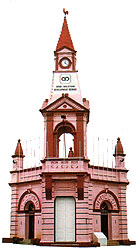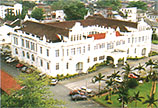Traveller's impression of Taiping: |
 |
... this important Chinese town, with a
street about a mile long, with large bazaars and shops making a fine appearance, being
much decorated in Chinese style; halls of meeting for the different tribes, gambling
houses, workshops, the Treasury, a substantial dark wooden building, large detached
barracks for the Sikhs police, a hospital, a powder magazine, a parade ground, a
Government storehouse, a large new jail, neat bungalows for the minor English officials,
and on the top of a steep, isolated terraced hill, the British Residency..... Taiping is a thriving, increasing place, of over six thousand inhabitants, solely Chinese, with the exception of a small (Indian) population, which keeps small shops, lends money, drives gharries and bullock-carts, and washes clothes. |
| Taiping is tolerably empty
during the day, but at dusk, when the miners return, the streets and gambling dens are
crowded, and the usual babel of Chinese tongues begins. (The sentries of the Perak Armed Police) wear large blue turbans, scarlet coats, and white trousers. There are four hundred and fifty of them, recruited in India from among the Sikhs and Pathans, and many of them have seen service under our flag... They are splendid looking men, with long moustaches and whiskers, but they plait the long ends of the latter and tuck them up under their turbans.... When off duty they wear turbans and robes nearly as white as snow, and look both classical and colossal.... I have been awoke each night by the clank which attends the change of guard, and as the moonlight flashes on the bayonets, I realise that I am in Perak..... |
| Isabella Bird, The Golden Chersonese And The Way Thither, 1879 |
 |
 |
Not alone in hospitals did Thaiping lead the van of civilisation in the native states, for onn the old town being burnt down fine broad streets were laid out, shade-giving the trees being planted at intervals along the sides, good macadamized roads were constructed, and after a while |
| kept in a repair that would put to shame many a London thoroughfare. |
| Ambrose B. Rathborne, Camping And Tramping In Malaya, 1898 |
 |
 |
The town of Taiping (Chinese word - everlasting peace ) lies on the Larut alluvial mining field.... For nearly fifty years, this field has been turned over and over by tin miners... With the possible exception of the centre of the town itself there is probably not a square yard which has not either been worked for tin or covered with overburden. Even in the town itself mining is still, by special permission, going on, and were the cricker field between the two clubs to be put to auction as a mining |
| block it would find ready purchasers. The town itself is one of them most picturesque in Malaya. Its public offices are handsome and contain a fine State Council Chamber. The road from the railway station, a quarter of a mile down which is the resthouse, is the boundary between the native and the English parts of the town. To the north lies the English quarter. Arriving by motor from Penang one runs right through it, a little country city where houses dot a perpetual freshness of gardens. On the south of Station Road is the Chinese town, with broader streets than those in most Malaysian cities. The streets are shaded by rows of angsena tree, which at irregular intervals bursts forth into a riot of blossoms, even more yellow than those of the labrunum. These it rains down in golden snow upon the streets, providing a carpet fit for a Sultan, for yellow is the royal colour in the East. With its golden snow, the angsena spreads abroad an almost over-powering scent, even more sweet than the smell of the pinang blossom. Most of the towns in Malaya have planted this Pterocarpus indicus as shade tree, but in Taiping it has grown to a greater height than elsewhere. |
| Cuthbert Woodville Harrison, An Illustrated Guide To The Federated Malay States, 1911 |
 |
|